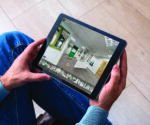Software from PST helps streamline manufacturing process at Liniar
 PVC-U systems company Liniar, a subsidiary of Quanex, has significantly streamlined its manufacturing processes thanks to a unique software solution from leading provider PST.
PVC-U systems company Liniar, a subsidiary of Quanex, has significantly streamlined its manufacturing processes thanks to a unique software solution from leading provider PST.
The industry giant employs Virtual Shopfloor, PST’s manufacturing-based software that allows fabricators to choose from a library of 3D model templates or create custom designs from scratch using a free form tool.
All designs are bespoke to the products they manufacture, and can be built on using easy to use drag and drop tools. Manufacturing and installation reports can then be generated with the option to send instructions directly to automated machinery.
Robert Corah, Liniar’s Secondary Operations’ Technical and Software Technician, comments: “Working with PST, specifically their software solution Virtual Shopfloor, has been a game changer for us at Liniar, not just because it’s user-friendly, but also because PST offers excellent customer service.
“Today, we’ve integrated Virtual Shopfloor into various aspects of our business, from manufacturing and sales to CAD. For instance, we create all our quotes for our customer network through Virtual Shopfloor’s retail version, making the quoting process simple and straightforward. Similarly, when it comes to manufacturing, it’s a seamless transition from quote to product specification.
“We’re currently using Virtual Shopfloor in manufacturing our range of conservatory roofs, our Elevate lantern roof system, and our Alumina bi-fold door system. PST is even helping us incorporate a decking and garden room system into the software, aiming to continually add more product ranges from Liniar.
“The true beauty of Virtual Shopfloor lies in its precision. When we introduced conservatory roofs to our range, we provided PST’s Managing Director Neil Travers with detailed dwg. files, and he used those exact specifications to create the products in the software. This means that when we draw a conservatory roof in Virtual Shopfloor and render it in 3D, we can examine an exact replica of the product, breaking it down to individual components. This ability to scrutinise every detail ensures that any errors are identified and rectified before we move to manufacturing.”











